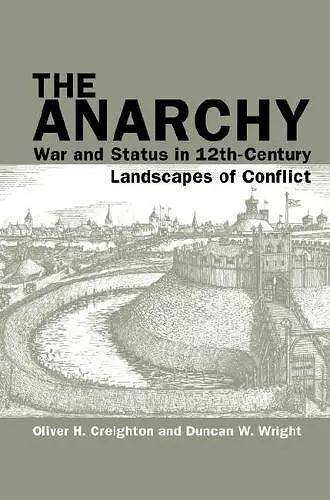The Anarchy
War and Status in 12th-Century Landscapes of Conflict
Duncan W Wright author Oliver H Creighton author
Format:Paperback
Publisher:Liverpool University Press
Published:15th Jun '18
Currently unavailable, and unfortunately no date known when it will be back

The turbulent reign of Stephen, King of England (1135–54), has been styled since the late 19th century as 'the Anarchy’, although the extent of political breakdown during the period has since been vigorously debated. Rebellion and bitter civil war characterised Stephen’s protracted struggle with rival claimant Empress Matilda and her Angevin supporters over ‘nineteen long winters’ when, according to the Anglo-Saxon Chronicle, ‘Christ and his Saints slept’. Drawing on new research and fieldwork, this innovative volume offers the first ever overview and synthesis of the archaeological and material record for this controversial period. It presents and interrogates many different types of evidence at a variety of scales, ranging from nationwide mapping of historical events through to conflict landscapes of battlefields and sieges. The volume considers archaeological sites such as castles and other fortifications, churches, monasteries, bishops’ palaces and urban and rural settlements, alongside material culture including coins, pottery, seals and arms and armour. This approach not only augments but also challenges historical narratives, questioning the ‘real’ impact of Stephen’s troubled reign on society, settlement, church and the landscape, and opens up new perspectives on the conduct of Anglo-Norman warfare
Reviews '[This book] successfully combines detailed archaeological considerations with careful historical assessment and thereby offers an important source for a range of scholars of military history, landscape studies and medieval archaeology... Certainly we learn a lot more about the ‘Anarchy’ and its various impacts and manifestations, and the ongoing problems with finding and reading the archaeology of the period.'
Dr Neil Christie, University of Leicester
'This excellent book reexamines the Anarchy, or the period of civil war between King Stephen and his cousin Mathilda (1135–54), integrating into the substantial historiography of the period a growing data set of archaeological findings and the insights of landscape studies to better illuminate the problems of the period. Although the book necessarily constitutes a sort of interim report, given the ongoing accumulation of material culture finds and excavations, it is a completely successful one that both synthesizes extant knowledge and points to potentially fruitful paths for further field research. For archaeologists and social, cultural, and military historians.'
S. Morillo, Wabash College, CHOICE
'For historians who study the Anarchy period specifically, several of the archaeological insights that Creighton and Wright provide will be helpful. For those who do not, this book stimulates thinking about the study and incorporation of material culture into historical discussion and debate for any era. Some of the maps and renderings are beautiful and offer interesting perceptions on the geographical scope of a long period of conflict but short span of time in ways that written description cannot match.'
Laurence W. Marvin, Berry College, Cambridge
‘This is an enormously valuable and engaging book, and it should now become essential reading for any who study Stephen’s reign, Anglo-Norman warfare, or indeed the social history of twelfth-century England.’
Matthew Strickland, Landscape History
'This excellent and elegantly produced volume not only offers challenges to some of these more established orthodoxies, but points up how studies of material evidence — the datasets for which will only grow thanks to the Portable Antiquities Scheme — can contribute to the bigger questions of the period.'
Robert Liddiard, University of East Anglia, Medieval Archaeology
'It is an agenda-setting work, positioning archaeology as neither a subservient adjunct to history nor its wilfully ignorant antagonist. Instead, it sensitively positions conflict archaeology (generously defined) as a complementary and powerful array of approaches and sets of evidence with the potential to unlock regions of historical enquiry that other disciplines cannot reach. Overall, this a very useful introduction to the issues surrounding twelfth-century warfare in Britain and in many ways a pioneering work.'
Thomas J.T. Williams, British Museum, Cambridge Archaeological Journal
‘The material evidence that the book brings out from twelfth-century England is fascinating and valuable … it certainly shows the broader material milieu within which the conflict was fought, and thus valuably serves to advance our understanding of the Anarchy.’
Medieval Review
'Creighton and Duncan Wright have gathered a generation of archaeological, art historical, sociological and historical research into a single study which presents a compelling and convincing multi-dimensional reinterpretation of King Stephen’s reign [...] what Creighton and Wright have achieved is a transformative argument that will impel archaeological and historical study in new directions. The challenge has been laid down to other scholars to test the new prescription.'
Richard Oram, Archaeological Journal
‘The Anarchy is an incredible example of the kind of innovative scholarship that can be produced through interdisciplinary methods. Although Creighton and Wright delve into the details of archaeological excavations, they do so with a style that is easy to comprehend and free from jargon. This style of research shows the fruits that come from integrating archaeological studies into historical narratives informed heavily by texts, while recognizing the shortcomings of both pools of evidence.’ Matthew King, H. Net
ISBN: 9781786941855
Dimensions: unknown
Weight: unknown
346 pages